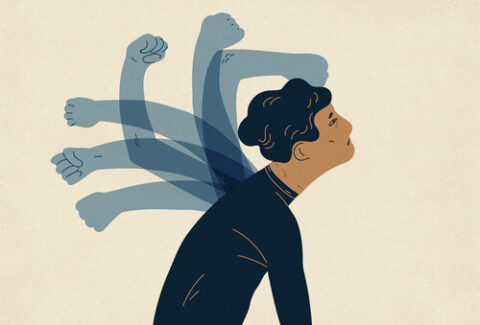The Color Purple And The Patients And Clients We Serve: A Psychiatrist’s Perspective, Part IV

The Color Purple And The Patients And Clients We Serve: A Psychiatrist’s Perspective, Part IV
“Love is all we need,” were the first five words Maya said to me, as she took her usual seat in my office. And as usual, my response to these kinds of doorknob comments was silence, as I waited for her to continue. I allowed the time for Maya to organize her thoughts and then she added, “I think I am Celie and I have found my Shug, and I now feel empowered and liberated.”
In the third article of this series, I mentioned how Maya had asked me the question, “Which one do you think I am, Celie or Nettie.” I explained that she was alluding to the movie, The Color Purple, and in two previous articles, I recounted that she had asked: “Have you seen The Color Purple?” After her question, she followed with a zealous discussion of the movie, and because I had only seen the Broadway show and not the movie, I decided to see it in my attempt to better join with Maya. Her enthusiastic discussion and the related emotions have led to this series of articles.
In the first article of these series, I elaborated on two essential points in the movie that mirror the lives of the patients and clients we all work with in the public sector: Child abuse and survival mode. In the second article, I elaborated on two additional essential points: Early loss and social injustice and what they mean for our patients and clients. And in the third article, I illustrated moments of empowerment and self-liberation, and the catalyst or driver of empowerment. I also discussed relationship as a vital driver for empowerment and recovery.
In this current article, I will elaborate on the specific elements of a relationship that catalyze this moment of empowerment and self-liberation.
1. Social Support
Celie lost both of her parents and only had her sister, Nettie, from whom she was taken away, after her marriage to Mister. When Celie reunited with Nettie, things quickly became different for her. Together, they sang, and they played, which allowed her to be the fourteen-year-old child that she really was. Celie felt supported, especially as Nettie, who went to school, taught her how to read. In previous articles on Social Determinants of Health, I illustrated how social support is one of the crucial aspects of anyone’s life, and it is, indeed, one of the essential components of how relationship can catalyze empowerment, self-liberation, and recovery.
2. Friendship
Related to social support, friendship can be a powerful tool to promote healing and recovery. Celie was married and living with Mister, but did not have a friend until Nettie reunited with her. This friendship ended after Mister threw Nettie out of the house and secretly held on to all the letters from Nettie addressed to Celie. It was not until Sofia moved in to the house that Celie had another friend, but that friendship did not last long, because Sofia moved out of the house after leaving her husband, Harpo. A third friend came along, who seemed to have been more consistent. The friendship lasted longer, making a significant difference in Celie’s life. Do your patients and clients have friends? If so, what types of friends do they have? What do they do together? What do they talk about? What do they have in common, and how might they be different?
3. Positive Relationships
There is social support, there is friendship, and then there is the positive relationship. As I mentioned earlier, the life of marriage to Mister and caring for his children did not necessarily translate into a social support for Celie, much less a friendship, or a positive relationship. The types of friendship that our patients and clients have are more important than whether or not they have any friendships. There is a Mexican proverb: “Tell me who your friends are and I will tell you who you are.” A friendship can be detrimental to our patients and clients unless it is marked by a positive relationship. Like Henry Ford once said, “My best friend is the one who brings out the best in me.” In The Color Purple, Shug did just that for Cellie, and that cemented her journey to empowerment and recovery.
4. Positive Love Experience
A positive relationship in a positive friendship allows for a positive and strong social support and this can lead to a positive love experience. Love was for a long time foreign to Celie. She had not experienced it for a long time since Nettie had left. She had not possessed the ego strength to know or to learn to lean on herself. Her physical and emotional abuse and neglect shaped her belief that she did not deserve to be loved. “Why do you cover your smile, Celie … Celie, you have a beautiful smile, come here.” Shug made these remarks to Cellie, while putting her in front of the mirror, holding her hand, making sure she was able to see her smile, on her own, her beautiful smile, one she had been hiding. Celie had a surprising reaction when she saw her own smile, which she seemed to have consciously and intentionally observed for the first time. Maybe she had been covering her smile because she thought it was ugly. After all, she had been told she was ugly, by her stepfather, who in turn fathered her two children. Maybe she thought she did not deserve to smile, that she did not deserve to be happy, and that any expression of her happiness, through her smile, needed to be undone by covering her mouth. Or maybe it was a combination of all these and many other explanations. What we know for sure is that a positive love experience in her friendship with Shug made a significant difference in Celie’s life.
5. Inspiration and Hope
Inspiration is everywhere. Our teachers, mentors, coaches, analysts or therapists can all inspire us one way or another. Our patients and clients, our friends, relatives, and other relationships can inspire us, too. With inspiration can come hope, with hope can come the willingness to go on, to keep trying, refusing to give up, and this is another crucial component of a positive relationship, leading to empowerment and recovery. Shug was a source of inspiration for Celie and for many others, including Harpo’s second wife, who, too, had the audacity to get up and say, “I, too, am leaving. I am going with Shug. I always wanted to be a singer.” Who inspires your patients and clients? Where do they seek their inspiration? Who gives them hope?
Love, work, and play.
Sigmund Freud, a neurologist, who wanted a reliable method to study the part of the brain that was so complex that no imaging technique would ever be able to capture its essence—the mind. Decades of his work led to what we know today as psychoanalysis, and he thought that love, work, and play are three main ways we can assess any of our patients’ full recovery. Despite Celie’s early losses, her intense physical, emotional and sexual abuse, and her severe physical and emotional neglect, she eventually reached a point where she was able to love, as evidenced by her love relationship with Shug, and to work, as evidenced by her work as a seamstress, after she had finally left Mister, and she was able to play, as evidenced by her great sense of humor, her play with Nettie and Shug.
Many fail to understand what we do, which makes it easy for them to undervalue it, especially when those we serve, in the public sector are the indigent, the underserved, the underprivileged, whose voting rights have been taken away from them, who cost more to the economy than they may be able to contribute, and the majority of whom do not look like the typical person we think might deserve better. Nonetheless, you are doing this work because you know better, because you believe that each and everyone deserves health and recovery, just for the fact that they are human; and that this recovery will take place through empowerment, which in turn takes place when there is a consistently safe place for our patients and clients, a place that we hold in our offices or when we are in the field.
References:
-
Holt-Lunstad, J., Smith, T.B. & Layton, J.B. (2010). Social Relationships and Mortality Risk: A Meta-analytic Review. PLoS Med, 7 (7).
-
Vaillant, G.E. (2012). Triumphs of Experience. The men of the Harvard Grant study. Belknap Press: World.
-
Hendriks, M., Ludwigs, K. & Veenhoven, R. (2016). Why are locals happier than internal migrants: the role of daily life. Social Indicators Research.
-
Accordino MP, Herbert JT (2000) Treatment outcomes of four rehabilitation interventions for persons with serious mental illness. Journal of Mental Health Counseling, 22(3), 268-282.
-
Anthony WA (1993) Recovery from mental illness: The guiding vision of the mental health service system in the 1990s. Psychiatric Rehabilitation Journal, 16, 11-23.







